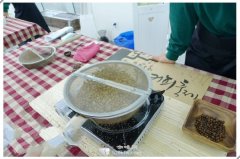SCAE barista certification standard
There are a large number of "barista training institutions" around the world, but there is no independent testing and certification mechanism based on knowledge and production capabilities. Just like getting a driver's license, the European Special Coffee Association will get our certification no matter where you received the training or even learned it yourself, you only need to pass our written, oral and hands-on tests. Our tests are based on the most common international standards.
Because the role of modern baristas has gone beyond espresso machines and bean grinders, our tests will include the use of other production tools, as well as general coffee knowledge.
The three levels we have divided are:
First-level standard, junior barista
A record of six months' working time is required, which can be in a coffee shop, a coffee roaster, or a coffee seller
The test includes three aspects of written test, namely, basic coffee knowledge, including coffee planting, processing, grading, roasting and tasting.
Basic knowledge of coffee making, theory of coffee extraction, and basic knowledge of other common coffee making methods
Basic knowledge of espresso, including coffee machine, bean grinder, machine operation, coffee, making and various coffee drinks
There are also simple practical tests.
Secondary standard, intermediate barista
One year's work record is required and passed the test at the next level.
The content of the written test is the same as before, except that it is more difficult.
The test is more difficult, and there is also an oral test.
Level III standard, senior barista
Two years of work record is required and passed the test of intermediate barista.
Written tests, oral tests, and practical tests are all in accordance with expert requirements, including coffee tasting.
Important Notice :
前街咖啡 FrontStreet Coffee has moved to new addredd:
FrontStreet Coffee Address: 315,Donghua East Road,GuangZhou
Tel:020 38364473
- Prev

About coffee roasting
Coffee roasting (coffee roasting) means that through heating raw beans, starch in raw beans is converted into sugars and acids at high temperature, substances such as cellulose will be carbonized to varying degrees, water and carbon dioxide will be volatilized, proteins will be converted into enzymes and fats, and the remaining substances will be combined to form an oil film on the surface of coffee beans, and in the process coffee acids will be formed.
- Next

Various acidic substances in picking coffee
We all know that coffee contains a lot of organic and inorganic acids, which have a great impact on the taste of coffee, but most people do not have a chance to understand the effects of various acids. The following article will talk about the relationship between various acids and coffee! One: citric acid-Citric Acid citric acid is commonly found in
Related
- Beginners will see the "Coffee pull flower" guide!
- What is the difference between ice blog purified milk and ordinary milk coffee?
- Why is the Philippines the largest producer of crops in Liberia?
- For coffee extraction, should the fine powder be retained?
- How does extracted espresso fill pressed powder? How much strength does it take to press the powder?
- How to make jasmine cold extract coffee? Is the jasmine + latte good?
- Will this little toy really make the coffee taste better? How does Lily Drip affect coffee extraction?
- Will the action of slapping the filter cup also affect coffee extraction?
- What's the difference between powder-to-water ratio and powder-to-liquid ratio?
- What is the Ethiopian local species? What does it have to do with Heirloom native species?

